(New Instrument of Threes)
- page five -
(The Study of Threes)
http://threesology.org
The Threes Phenomena shows the repetition of an underlying brain activity that leads humanity to a shore whose horizon is reflexively responded to as if it were the wall of a cage within which an animal paces to and fro, creating all sorts of illusions and indulging in activities concerned with trying to or wanting to be unlimited— like a child who thinks they are coloring outside the lines, yet do so in the confines of the same page, or different pages within the same coloring book kept in the same place in the same room... etc...
Despite all of humanity's presumed advances, it constructs such within the boundaries imposed by limitations, like those who learn to use crude tools to fashion something that a future age will marvel about because no one then, with all their tools of sophistication, can accomplish the same thing. And yet, all are efforts of attempting to adopt, by way of adaptation, to an environment headed for a demise. Such "advances" in thought and deed delude perceptions from recognizing that all the limitations are but environment-specific survival mechanisms. Getting away from our present environments will set into play the beginning steps beyond all these limitations, that is, if they do not have a wide-spread generalization. And this also does not exclude the realization of other types of limitations being discovered.
Here are three who have surfaced realizations of limitations within the scope of their related professions:
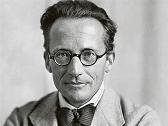
Erwin Schrödinger (1887-1961)was an Austrian physicist who is widely remembered for his "Schrödinger's cat" experiment dealing with wave propagation that was later identified as being equated with a perspective of the Heisenberg principal. He intended his thought experiment as a discussion of the EPR article named after its authors Einstein, Podolsky, and Rosen in 1935.
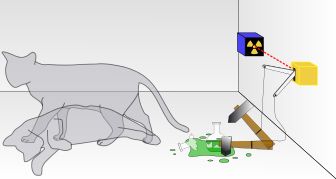
Schrödinger's cat— Let me present a portrayal of the experiment from a wikipedia source but slightly alter its comments so that it is adjusted to the present context. It is important to stress how simplistic it actually is and might be termed "child-like", with no disrespect or derision intended, but to convey its originality as being easy to understand. However, its simplicity is obscured by the level of "serious" mathematics, attitudes and personalities involved applied in a "serious" context to like-minded individuals who take themselves very seriously,... but often with circumspect humor as when Einstein stuck his tongue out at reporters who had been taken numerous photographs of him at a given time. Please also note the presence of the "three" as a fundamental structural model, which includes the origin for the construction of the experiment due to the "E.P.R."— three person article. The "thought experiment" involved three items:
These three items are placed in a sealed box. If we include the box as a specific in the equation, we then have a 3 -to- 1 ratio. Such that we have three items in one box. (Note: let me remind the reader that a "box" is the identification of an imposed limitation, even though the three items themselves, likewise are imposed imitations just like any syllogism and might be considered to be named the "exclusionary principle" when devising experiments, thought or otherwise.) If an internal monitor detects radioactivity (i.e. a single atom decaying), the flask is shattered, releasing the poison that kills the cat. If you do not use a hammer as the illustration shows, you will need to imaginatively construct a means by which the poison is released. The flask doesn't need to be shattered, it could simply be over-turned. Use of a hammer to shatter the flask implies destructiveness. In any event, the decay of an atom, the shattering of the flask and the killing of the cat is three forms of decay. If we include the notion of a hammer and means of radiation detection along with the box, we have an additional set of three items. The Copenhagen interpretation of quantum mechanics implies that after a while, the cat is simultaneously alive and dead.
Yet, when one looks in the box, one sees the cat either alive or dead, not both alive and dead (which implies a third state of existence though Schrödinger needlessly complicated the issue by coining the term "Verschränkung", meaning entanglement). This poses the question of when exactly quantum super-position ends and reality collapses into one possibility or the other. (However, this also implies that super-position may not end except that the human mind has been trained to seek out a dichotomy... a polarization, as a type of mental regression when confronted by a circumstance confounding someone level of comprehension applied to a given context. On the atomic level, this presumed "third state" between life and death might be referenced as another traditional theological proposition being referenced in quantum terms... though I refrain from calling it a religious question since religion often attempts to validate itself by assuming ownership not only of "uncertainty principles" related to many human issues, but also having assumed answers for most, if not all concerns and questions. Adjusting one's thinking to a third overall alternative is difficult for some because it requires thinking "outside the box". Just because the human physiology has difficultly in capturing the super-position in its conscious perception for an extended length of human-perception-specific time, doesn't mean the duration is actually short —or indefinitely persists—, when measured on the quantum scale.) Such a remark is addressed with the concept of the "observer effect", and is well-known both in and outside the realm of physics. Most often, however, it is a known variable applied in a given context and is not recognized as being part of the "boxed-in" context itself. In other words, it is seen as a variable that can cause misperception, but is not considered as a misperception in the first place. It is a misperception because it is misunderstood; which causes it to be misidentified and mislabeled... resulting in additional "observer effect" variables. |
Now let me pose a question in order to interject some examples of "threes":
What if humanity is part of a type of experiment? And this is regardless if you call it a thought, god, extra-terrestrial, accident, random, etc., experiment. Whereas the three above items are not aware of participating in an experiment, and some humans prefer to think that life is not a process based on experimentation, though some evolutionists might, to some degree, disagree; what if we can nonetheless affect the experiment by introducing an unexpected thought process because it is an undefined type of "uncertainty principle"?
And I don't mean affecting the presumed experiment by way of a destructive measure, or some stupid theological, sociological, political, new age or business preoccupation, or any of the other traditional nonsense running rampant in many urban legend forms; many of which are traditionalized into absurd proportions of belief that are contradicted by everyday reality outside social spheres of influence on thinking, but an alteration in our thinking as a means of thinking ourselves out of the experimental box which far exceeds our present grasp of reality?
In such a sense, the word "humanity", like so many words and items used as self-referencing, (such as fraternity, genealogy, brotherhood, state, nation, public, etc.,) are little more than different types of umbilical cord and apron strings. When we look at the origin for the impetus for the experiment we are a part of, we do not see a three "EPR" article, which might be better framed as a "PRE" article to note a suffixed beginning, we can identify several other "threes". The following image is meant to be illustrative and not a comprehensive portrayal of the very many more "threes" which could be included involving different aspects of history:
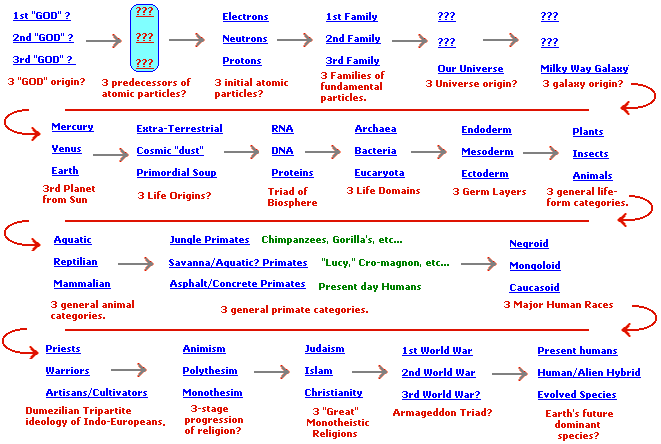
|
Let's now proceed with the second of three "guests" in our discussion. The Information was compiled from the Wikipedia and two other sources (an online Wordweb dictionary and the desktop New American encyclopedia):
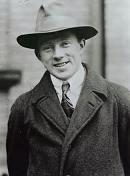
Werner Karl Heisenberg (5 Dec. 1901 – 1 Feb. 1976) was a German theoretical/mathematical physicist. He is one of the key creators of quantum mechanics. He published his work in 1925 in a breakthrough paper. In the subsequent series of papers with two others: Max Born and Pascual Jordan, during the same year, this matrix formulation of quantum mechanics was substantially elaborated. In 1927 he published his uncertainty principle, upon which he built his philosophy and for which he is best known. He is noted for stating the uncertainty principle applied to quantum theory: "It is impossible to measure both energy and time (or position and momentum) completely accurately at the same time."
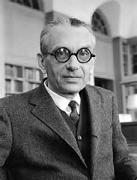
Kurt Gödel (born in Austria, April 28, 1906 – January 14, 1978) was a United States mathematician who is widely remembered for demonstrating the limitations of axiomatic systems.
He also showed that neither the axiom of choice nor the continuum hypothesis can be disproved from the accepted axioms of set theory, assuming these axioms are consistent. The former result opened the door for mathematicians to assume the axiom of choice in their proofs. He also made important contributions to proof theory by clarifying the connections between (the three):
- Classical logic
- Intuitionistic logic
- Modal logic
It is of some interest to note that the so-called advanced mathematics had been using the same old non-sensical syllogistic-based (gaming) logic structure to prove and disprove theorems within a given context. It was little more than the use of mathematics as an artistic expression of word-rendered ideas involving a contrived methodology like a set of rules to be played in order to play a particular game in "the right way". So much time, effort, and money spent on intellectual games which give themselves a veneer of respectability by way of applying fundamental mathematics to practical interests in different venues so that those with an interest in "metaphysically-based" mathematical interests will be free to engage in their respective mathematical logic.
Like the clergy of old who wanted to have time to study, think and have some measure of a livelihood in order to pursue their intellectual interests in an environment of like-minded others... It's just another variety of the Middle ages where these "mathematical or physicist monks" wear different garments, their monastic retreats are called universities or research centers, and they want the public to believe they are engaged in a higher purpose for the sake of humanity. What a socialized intellectual merry-go-round humanity has devised for itself. And it is a cycle of behavior that is well-recognized and supported because it in turn reciprocates, like a church protecting and promoting a king that promotes the church. Yet, good does spring forth on occasion, and might well be less if we did not have such a social game-in-play. Games can not be improved on, completely changed or set aside for something better unless the limitations are exposed and something more useful is provided.
Now permit me to mention one more individual since his work is frequently referred to. Namely, Max Planck (1858-1947), a German physicist whose explanation of black-body radiation in the context of quantized energy emissions, initiated quantum theory. He evolved the Planck Radiation Formula which implied that energy, like matter, is not infinitely subdivisible— that it can only exist as "quanta" (smallest discrete quantity of some physical property that a system can possess). However, Planck was unconvinced of this, even after Einstein had applied the theory to the Photo-electric effect and Bohr to his model of the Atom. Planck is commonly remembered in terms of the Planck's Constant: The constant of proportionality relating the energy of a photon to its frequency. In other words, it is like so many equations using a basic three-part structure: PE (photon energy) ≡ (is equivalent to) F (its frequency)... = (equals) approximately 6.626 x 10^-34 joule-second.
It is important not to overlook the equivalency of the words "constant" and "limitation". By way of reiteration: A constant is also a limitation and a limitation is also a constant. If they are not, then we must revise our thinking. If energy and matter are not infinitely sub-divisible, this implies limitation and therefore renders a constant in terms of being finite in divisibility. In other words, the limitation or constant we are perceiving are themselves part of an unrecognized uncertainty principle. By extension, if the development of atomic nuclei evolves by way of divisibility (and/or fusion) of other nuclei, was there a single "first" atomic form that divided? Assuming a single source, were all that exist today, existing as one, or "in" one "area" in the past? Will new "species" be found isolated in regions of space like isolated primitives or unknown life forms?
If we apply this idea of "limitation and constant" to the puerile question concerning the notion of (a) God, and say God is limitless, than such a state says God is a constant unlimitedness. And whether or not we apply the term "consistent" to this notion, brings forth the idea of being indeterminate. Yet such a constant also renders itself towards being explained or defined as a limitation even if you refrain from naming or attempting to describe (a) God. By the very fact that humanity can conceive of such renders any such entity with limitation, that is if we assume because humans are limited any and all conceptions are already an expressed limitation; and yet if humanity has the capacity to think beyond its own humanness, beyond its own biologically-induced constraints, we do ourselves a great injustice by practicing very many contemplations of open-ended nonsense... hence the reason many proscribe rules, axioms, tenets, laws, procedures, etc., to give some measure of form and function to energy expenditure.
By way of a reflective pedagogical explication: attempting to measure both a particle's position and momentum; while we sight one, attempting to sight the other remains allusive. The problem with the uncertainty principle is that it may actually be an "under-certianty" concept, in that it has forced many into the constant of not only thinking in terms of the Heisenberg principle, but excluding any notion beyond its two-patterned formula stated as Position and Momentum. There may be a third element that is being excluded and requires a new atomic theory in order to visualize it; such that the present discussion might well be the metaphysical notion which prompts others towards a consideration thereof... from which springs the realization of an acknowledged existence which can be experimentally verified.
If we look at a particle as if it were a person or even (a) God, which might well be used to metaphorically (or allegorically) describe perception and uncertainty; most fail to recognize the descriptive beyond a two-part, for example, mortal and immortal classification. While this is not wrong, like denoting the two-part off/on of an electrical circuit such as a light switch; such a characterization delimits the application for a greater realization such as in the electrical sequencing for computers when the two is altered to a three-based (boolean) logic such as And - Or - Not. By way of analogy, if we alter the concepts of "position and momentum" to that which has a logic commensurate with a three-based formulaic expression such as that used to describe (a) God: Om-niscient ~ Om-nipotent ~ Om-nipresent; we arrive at the relativity that the Uncertainty principle is actually an Under-certainty principle.
(The reader should be familiar with the concept of "Om" as a two-part portrayal of the three-lettered "AUM", which is said to be the greatest religious meditation chant of India, and suggests a link with the [worshipped] ancient Egyptian sun-god Amon-ra..., from which the present day "A-men" after a prayer is said, and is hence, the reason for the hyphenation of the foregoing three. The "A and U" in the expression 'Aum' coalesce {fuse} together to produce an "O".)
Position and momentum of a person is like giving them a social security number aligned with an attempt to guesstimate their age, but all other defining characteristics which may influence position and/or momentum are being considered as negligible. Whether such an analogy has a comparable level of application to atomic theory might require a new atomic theory in the hands (and) heads of a new generation of physicists and mathematicians. Whereas qualities like up, down, etc., with fanciful names are presently used, such might well be similar to the intelligence of a primitive devising a rudimentary form of descriptive psychology largely based on generalizations.
The three meditative "OM-nis" attributed to (a) God provide us with relative position, energy, and momentum. By comparison, the Uncertainty Principle seems more like a religious reference than one with a strict scientific intent. While we might say that (a) God is everywhere, how do you render this "everywhere" place into a mathematical expression when we don't actually know what this "everywhere" means? The same goes for all-powerful and all-knowing. While we recognize the usage of three general references, and might simply assign letters such as A, B, C to denote these concepts, we have lost track of the concept development from a two-based "Uncertainty" to a three-based characterization which necessarily identifies the former principle as having been an "Under-certianty" consideration.
It is not customary for some people to look at the uncertainty principle as a dualistic proposition being used to describe two separate characteristic of the same thing at the same time like a person who alternatively crawls, runs, skips, somersaults and walks between two football goal posts. Whereas you might collectively say both are assumed in the single concept of uncertainty, it doesn't answer the two separate questions as they are asked in a single sentence. Within this configuration, the addition of an alternative proposition might be interpreted as complicating instead of simplifying the issue. However, those steeped in the two-part array are unable to recognize both at the same time in order to see a third consideration of position - property - potential. While the "position" and "potential" terms are easily associated with "position" and "momentum", since "momentum and potential" can be aligned with "energy", the usage of the word "property" can be either/both/or separated from the other two. It can be both an amalgamation, a construct by way of divisibility, or an item unto itself.
If you are a person walking with a large crowd between two football or soccer goal-posts, how do you tell someone on the top bleachers of a filled stadium, exactly where you are, how fast you are going, and how to be identified, particularly if you know only the approximate position, momentum (of active searching) and place they are sitting, standing and perhaps shouting for you? And now couple the problem with the fact that if you stop walking and attempt to wave, everyone else does the same. And the same behavior of the person looking for you is mimicked by everyone else in the stadium... even the refreshment vendors. What is needed for either/and you or your counter-part to be further identified in all regards? And yet, you must think outside this "you and yours" dichotomy to include the "them or they" others. In other words, identification can well be established by an alteration of the third, typically unconsidered element.
Retrospectively stated, Planck's constant (as well as the other aforementioned limitations), may be more a description about perceptual limitation (called the observer effect), derived from an interpretation of a limited set of collated information, that one may assume is being taken into consideration while reading this descriptive, but is actually a definitive distinction highlighting a specificity. Hence, the list used may be too little of a sampling because someone's mind cannot comprehend more than a given sampling because conventions of thought sabotage their ability to appreciate the extent to which their own mind can ambush them and involve them in one or more different scrapes (wrestling or out-right intellectual fisticuffs with oneself). A larger sampling may entail multiple subjects like that covered in a "threes" perspective.
For example, currently, we have the two-part wave and particle theory applied to atomic behavior. And we have experiments which appear to agree with this theory. The problem arises when we take in more information outside the scope of physics which suggests a recurrence of a "threes" arrangement that may or may not have a precedence which should be considered for application. Whereas we say there are three fundamental particles (electrons, neutrons, protons), and collate all known particles into a three-family system, the usage of a "two"-patterned structure typology (wave and particle) may indicate we are either wrong, that there is a third form, or that the form "two" -to- three pattern portrays a sequential evolving type of development. Hence, we may also be able to spot a single or singularity as a precursor to these two. And we must further consider that the "three" pattern orientation presently in usage may be a precursor to yet another development, that I will not label a "forth", but as a 3 -to- 1 ratio outgrowth.
Note: While the following information is recreated from page two in this series, with a slight alteration of the examples in the table, it should be noted that repetition is needed to apply the same ideas in different contexts, similar to using the same crescent wrench for a different task by adjusting the blades width, instead of using a different-sized wrench altogether.
In defining the "wave" effect of particles I have used the term "linear", and for the "particle" designation, I have used "circular", though such terms may be more inferential than absolute. Nonetheless, such references permit the usage of "linear and circular" as basic geometric forms to which we can apply a third, namely, "triangular" form. By associating these three, I have put together a small sampling of related ideas that might also be reduced to similar geometric forms:
The following list of Linear- Circular- Triangular examples is for those who can easily visualize the printed word:
| "3" Basics Formula | Linear | Circular | Triangular |
| 3 galaxy/universe items | Our galaxy through space | Motion of galaxy | Expansion/Contraction{<>,X} |
| 3 basic Earth motions |
Unidirectional(?) Universe expansion A → B |
Rotation of Earth | Precession of Earth's axis (conical) |
| 3 forms of matter | Liquid | Solid | Gas |
| If we include "Plasma", this makes a 3 -to- 1 ratio. | |||
| 3 fundamental forces | (N)electro-magnetism(S) | Gravity | Nuclear - + + and - |
| 3 dimensions | Length ¾ |
Width (breadth) O |
Depth D |
|
If we include the assumed dimension know as "Time",
this makes a 3 -to- 1 ratio.¹ (The concept of time involves linear, circular and triangular notions... but so does playing a game of pool... which is often used to illustrate quantum physics ideas.) | |||
| Pool or billiards: | Cue Stick | Pool Balls | Pool Ball Rack |
| 3 conceptual models: | Primitive (Singularity) A dual form of singularity |
Native American (Duality) A circular form of duality |
Indo-European (Triangularity) A plurality of threeness |
| 3 (hair) cross-sections | African: ribbon-like | Asian: circular | Caucasian: ellipsoid |
| 3 Earth shape concepts | Earth is flat | Earth is round | Earth is a triaxial ellipsoid |
| 3 Universe theories | Universe is flat | Spherical | Saddle (triangular)-shaped |
| 3 physics ideas | String theory | Particle theory | Multi-dimensional theory |
| 3 stone tool shapes | Mono-facial | Bi-facial | Tri-"facial" (3-pointed arrow heads) |
| 3 counting objects | Lines (on bones, rocks, etc.) | Pebbles, stones, (clay, etc.) | Cones (wedges) |
| 3 engineering tools | Lever | Pulley/Wheel | Fulcrum |
| 3 engine shapes | In-line, Slanted, horizontally opposed | Radial, Rotary | V-shaped |
| 3 shapes game | Paper (flat-linear) |
Rock (round-circular) |
Scissors (X-shaped/triangular) |
| 3 human face items | Eyebrows | Eyes | Nose |
| 3 playground items | Monkey bars/See-saw | Merry-go-round | Slide/Swing-set support |
| 3 in-vehicle views | Road, Stick shift, etc... | Steering wheel | Perceptual view of distance |
| 3 early industry tools | Staff, Poker | Pottery wheel, Kiln | Fire (flame), Bellows |
| 3 pre-industry tools | Stick (or bone) | Rock | Fire (flame) |
| 3 cyanobacteria shapes | Filamentous (string-like) |
Coccoidal (ball-like) |
Ellipsoidal (egg-shaped) |
| 3 stromatolite shapes | Flat-layered | Domical/Columnar | Conical |
| 3 building structures | Skyscrapers | Coliseums Stadiums,etc. |
Pyramids |
| 3 basic tree shapes aligned with altitude | Banana, Coconut, (palm) Low elevations |
Apple, Orange, etc. Middle elevations |
Pine, (coniferous) "Higher" elevations |
| 3 foot descriptions | Heal to Toe line | Balls of feet | Arch of foot |
| 3-in-1 necktie forms | Fronts-piece covers buttons | Encircles the neck | Triangle slip knot |
| 3-in-1 washing machine cycle status symbols Speed Queen Commercial washer Model # SWT91QN |
In Use (vertical line) Back and forth like an old scrub board |
Spin (circular "curlicue") |
Rinse (triangular water shape) |
| 3 bird-flight formations | Diagonal, Horiz., Vertical | "Bunched up" | V-shaped (also J/L/7 variations) |
Note: I used the symbols {><} and {X} to portray expansion and contraction. Did the Universe expand like a bursting ball in all directions or a selected direction? It is not certain if the "Big Bang" occurred at a single point and then expanded in all directions. Unless we care to consider that our Universe is the result of an implosion, which is 1 idea, then there are 3 other theories we can consider, which brings our overall formula to a 3:1 ratio. The other three being a Linear - Circular - Triangular expansion after the Big Bang. Also, if the expansion is slowing down, is there to be an eventual "Big Crunch?"
See expansion and contraction of Universe examples here: 3 branes page 3
Let me also provide one other example to the above list:
Stromatolites are the result of mat-building communities of mucilage-secreting microorganisms that have been on the Earth for billions of years. The key microorganisms in modern Stromatolites are cyanobacteria. The most common forms of cyanobacteria are string-like (filamentous), ball-shaped (coccoidal), and egg-shaped (ellipsoidal). The Domical and Columnar forms are said to grade into one another. Hence, we have Linear, Circular, and Triangular forms:
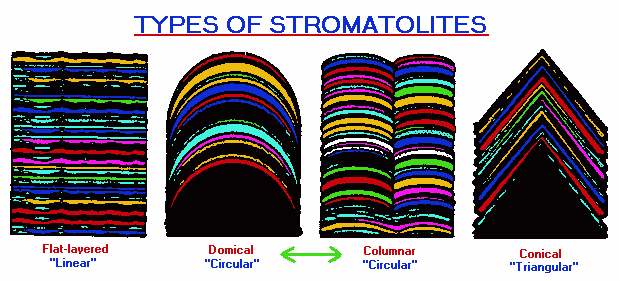
The Domical and Columnar forms are said to grade into one another. The overlapping of these two would thus provide us with 3 types of Stromatolites: (1) Flat~ (2) Domical/Columnar~ (3) Conical. If we consider that all forms tend to overlap developmentally, in terms of overall evolutionary processes, then we have a single origin probability.
And for those whose minds are not particularly troubled by extrapolations of thought into other areas of consideration, though they themselves do not necessarily believe in the type of application of the information, let me cite another example of form recognition involving the line - circle - triangle from another perspective that applies the information singularly but does not collate the same forms or (three-based) form assortment of references outside the given sphere of central interest.
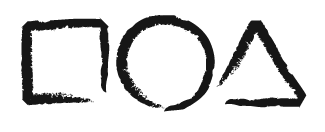 The hand of God at work!? In The Numerical Tarot:
|
In terms of a "Three" representation of number in antiquity, the developmental usage of symbolic ideation in a primitive setting might well have resorted to a usage of readily available markers such as rocks and sticks. When an attempt is made at reconstructing some semblance of primitive thought processing, there is a common exercise to compare the perspectives of children. An implied intent is to further attempt to reconstruct such simplicity of thought in the framework of an adult level of analysis such that one pretends to look at the world through the assumption of being able too see it as a child or primitive might. With this said, one might conceive of relating number concept to different items readily available within the given environment of one's grasp. By including the idea that primitive peoples used three number words frequently signified as "One - Two - Many", three differentiated items would thus be used. We might thus imagine linear sticks, with circular and triangular (or non-circular) stones to be used as a one-to-one grouping association. While the reader might want to interject a usage of fingers, knotted ropes or other methods, we might further identify basic linear, circular and triangular-like (less circular or edged) configurations as being represented.
Posting update: Saturday, October 18, 2014
HTML (4.01) update: Wednesday, May 29, 2019... 5:27 AM
Your Questions, Comments or Additional Information are welcomed:
Herb O. Buckland
herbobuckland@hotmail.com